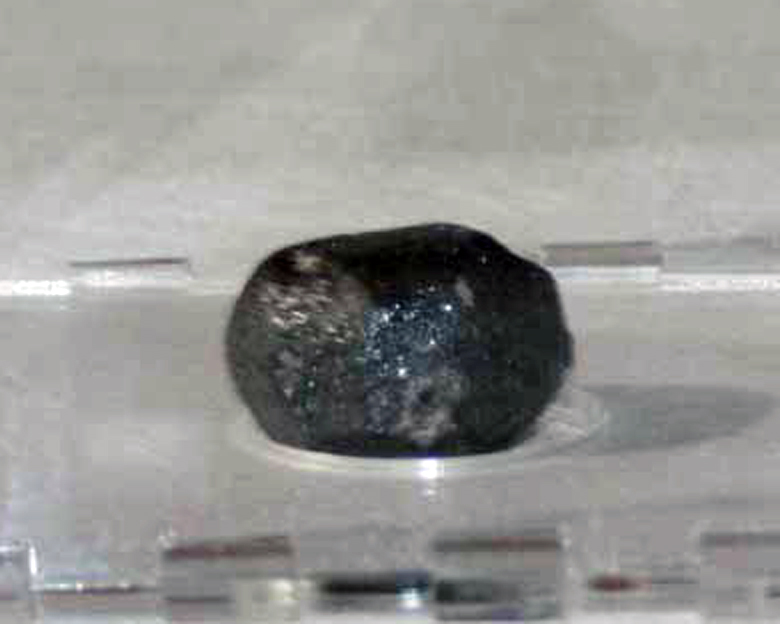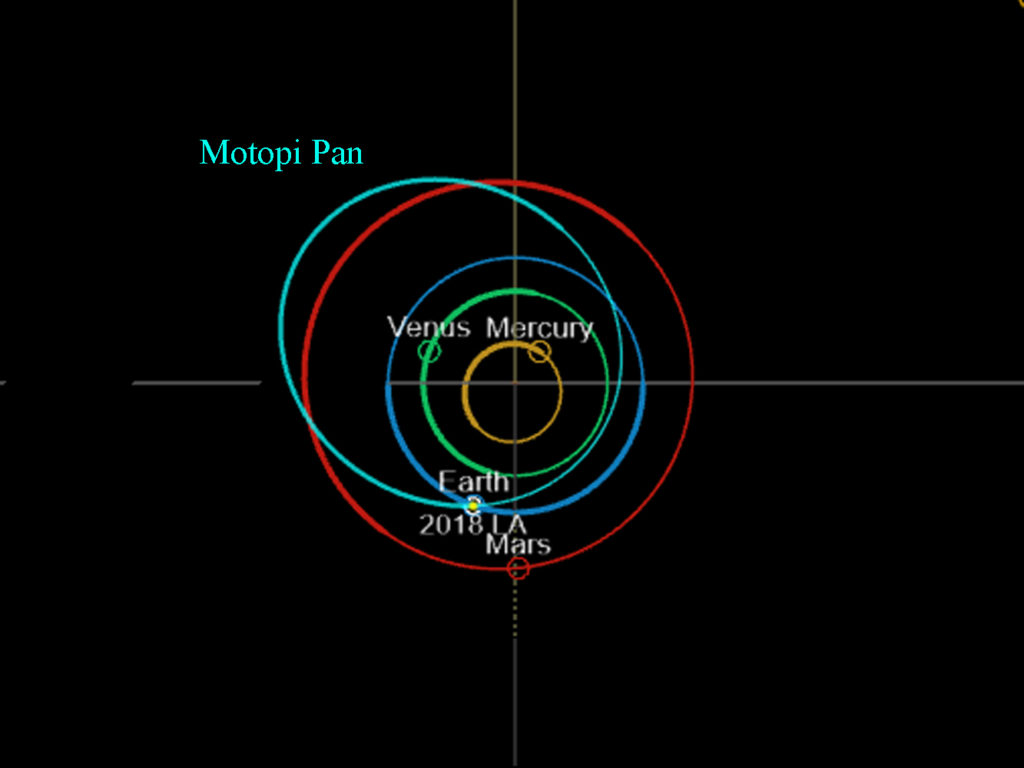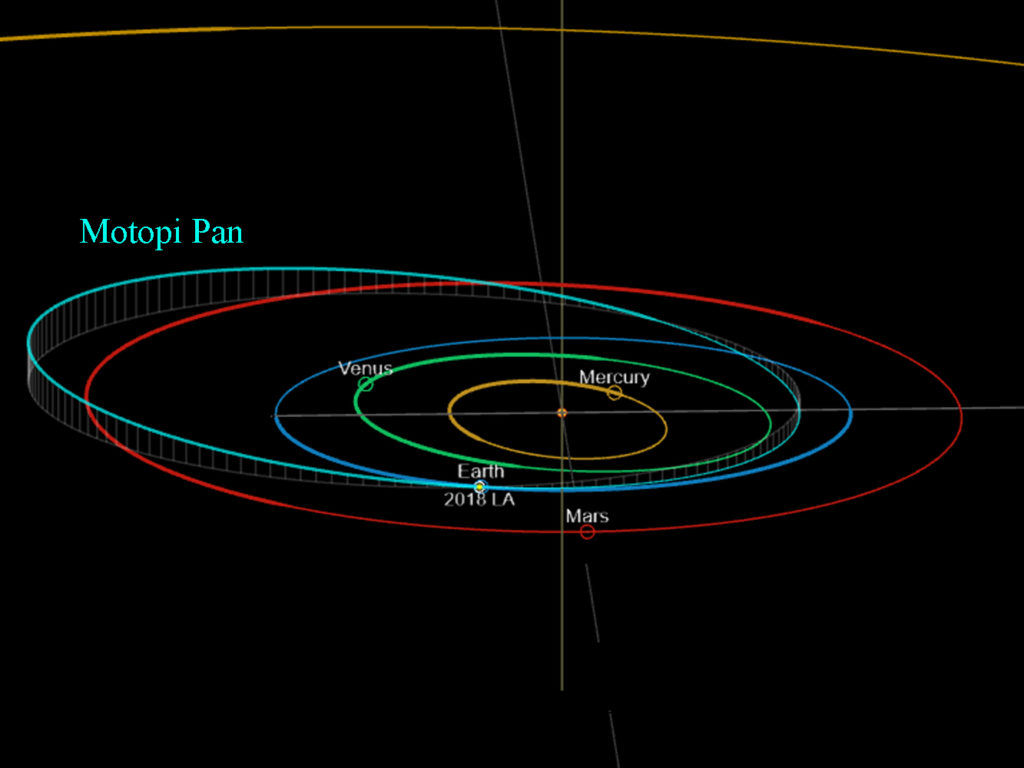MOTOPI PAN
24 MOTOPI PAN meteorites (214.5375 g, Howardite, polymict breccia) of Botswana bolide of 2018 LA (2 June 2018, 16:44:01.59-11.77 UT) found near Motopi Pan watering hole, Central Kalahari Game Reserve, Ghanzi, Botswana
Motopi Pan meteorite #1 (17.92 grams) in situ. Photo: Peter Jenniskens/Botswana International University of Science and Technology (BIUST)
At ~8.15 am on 23 June 2018, after five days of searching and on the last day of the planned search expedition, a team from Botswana, South Africa, Finland and the USA discovered the first Motopi Pan meteorite (17.92 grams) at location 21°14’55″S, 23°14’19″E in the northern part of Botswana’s Central Kalahari Game Reserve (CKGR) in Ghanzi district. The meteorite, named after a local watering hole, about 19.6 kilometres northwest of the find location, is an Howardite (HED polymict breccia) and was found by geologist Lesedi Seitshiro (BIUST) who had joined the search expedition as a volunteer. On the 17 June 2018 the search team of ORI and SETI (three persons in one car) joined the search team of BIUST and BGI (nine persons in three cars) in Maun. The joined search team was lead by Alexander Proyer (BIUST) and consisted of geoscientists from Botswana International University of Science and Technology (BIUST), Botswana Geoscience Institute (BGI) and University of Botswana’s Okavango Research Institute (ORI), including Peter Jenniskens (SETI), Professor Roger Gibson (Head of School at the School of Geosciences at the University of the Witwatersrand in Johannesburg, South Africa) and Tomas Kohout (FFN / University of Helsinki). The meteorite fell during the 2 June bolide of asteroid 2018 LA (ZLAF9B2) over South Africa and Botswana at 18:44:01.59-11.77 local time (UTC+2). The main flare of the bolide happened at 16:44:11.5 ± 3.0s UTC at an altitude of 27.8 ± 0.9 km above location 23.287 ± 0.057° E, 21.251 ± 0.007° S. The potential strewn field had been calculated independently by a team consisting of members of the SETI Institute in California and by Esko Lyytinen and Jarmo Moilanen of the Finnish Fireball Network (FFN). The results of the analyses were found to be almost identical and then combined. The calculated 90-km² strewn field was reported to be about 2 km wide and and 45 km long, crossing one of the main roads between the northern and the central part of the CKGR. The first Motopi Pan meteorite was found in the area of the calculated strewn field where small meteorites the size of the found specimen had been expected. Before the search expedition Jenniskens and Oliver Moses (ORI) had gathered available security surveillance videos in Rakops (118.2 km from location (ground) of main flare) and Maun (139.2 km from location (ground) of main flare), Botswana. Especially the indoor video from Rakops turned out to be useful for analysis. The available images were calibrated based on background stars by Jim Albers. Tim Cooper of the Astronomical Society of South Africa (ASSA) calibrated the videos to the south. Based on the calibrated video camera footage from Ottosdal (South Africa), Gaborone, Maun, Rakops and Ghanzi the meteoroid’s main disruption flare at an altitude of 27.8 ± 0.9 kilometres was triangulated and the potential fall area was calculated. Jelle Assink and Laslo Evers of the Royal Netherlands Meteorological Institute (KNMI) provided the important atmospheric wind data for the dark flight analysis. The calculated pre-atmospheric orbit is consistent with a Vesta origin. The cosmic ray exposure age of the meteoroid was calculated to be 23 ± 4 million years. Between June and October 2018 other search expeditions were done but did not result in any meteorite finds. During the sixth expedition in October (9-12) 2018 another 22 smaller meteorites (0.51 – 13.2 g) were found. Motopi Pan meteorite #2 (4.28 g) was discovered by Mohutsiwa Gabadirwe (Botswana Geoscience Institute). On 31 March 2019 the Meteoritical Society approved the Botswana Geoscience Institute (BGI) as an official meteorite repository and long-term curation facility. On 7 November 2020 Thato Makgane (BFP), participant of another expedition led by Fulvio Franchi from BIUST found a 92.3175-gram specimen, which is the largest mass of the Motopi Pan fall so far. Meteorites found in Botswana (as ‘relics’) are protected under Botswana law (Volume: XIII, Monuments and Relics, Chapter: 59:03) and must not be removed or exported according to Mohutsiwa Gabadirwe‚ senior curator of the Botswana Geoscience Institute. The search for more meteorites might continue. A second search team included Dr Fulvio Franchi (BIUST) and Tomas Kohout (FFN / University of Helsinki). Found meteorites will be curated at the Botswana National Museum and might be presented at BGI’s planned Geological Museum and Education Centre. A research consortium has been established consisting of scientists from Botswana‚ South Africa‚ Finland‚ and the USA. On 23 April 2021 the fall was officially registered in the Meteoritical Bulletin database as confirmed fall Motopi Pan (Howardite).

The known Motopi Pan strewn field. Red dots indicate the known find locations of 24 specimens found in 2018 and 2020. The sun symbol indicates the approximate location of the main flare at 16:44:11.5 ± 3.0s UTC at an altitude of 27.8 ± 0.9 km above location 23.287 ± 0.057° E, 21.251 ± 0.007° S. The red line indicates a distance of 16 kilometres. The yellow arrow indicates a section of the ground-projected trajectory of the bolide’s luminous trail (from an altitude of about 30 km). The exact termination height of the luminous trail is not known. Image: karmaka, based on Jenniskens et al., published on 23 April 2021.

The bolide’s luminous trail, its main flare, the find location of the 92-gram mass and the locations of four of the five cameras used for the triangulation. Image: karmaka, based on Jenniskens et al., published on 23 April 2021.
KML (download)
KML with labels (download)
The impact and recovery of asteroid 2018 LA
Meteoritics & Planetary Science, First published: 23 April 2021
Peter Jenniskens, Mohutsiwa Gabadirwe, Qing‐Zhu Yin, Alexander Proyer, Oliver Moses, Tomas Kohout, Fulvio Franchi, Roger L. Gibson, Richard Kowalski, Eric J. Christensen, Alex R. Gibbs, Aren Heinze, Larry Denneau, Davide Farnocchia, Paul W. Chodas, William Gray, Marco Micheli, Nick Moskovitz, Christopher A. Onken, Christian Wolf, Hadrien A. R. Devillepoix, Quanzhi Ye, Darrel K. Robertson, Peter Brown, Esko Lyytinen, Jarmo Moilanen, Jim Albers, Tim Cooper, Jelle Assink, Läslo Evers, Panu Lahtinen, Lesedi Seitshiro, Matthias Laubenstein, Nggie Wantlo, Phemo Moleje, Joseph Maritinkole, Heikki Suhonen, Michael E. Zolensky, Lewis Ashwal, Takahiro Hiroi, Derek W. Sears, Alexander Sehlke, Alessandro Maturilli, Matthew E. Sanborn, Magdalena H. Huyskens, Supratim Dey, Karen Ziegler, Henner Busemann, My E. I. Riebe, Matthias M. M. Meier, Kees C. Welten, Marc W. Caffee, Qin Zhou, Qiu‐Li Li, Xian‐Hua Li, Yu Liu, Guo‐Qiang Tang, Hannah L. McLain, Jason P. Dworkin, Daniel P. Glavin, Philippe Schmitt‐Kopplin, Hassan Sabbah, Christine Joblin, Mikael Granvik, Babutsi Mosarwa, Koketso Botepe
The Motopi Pan meteorites
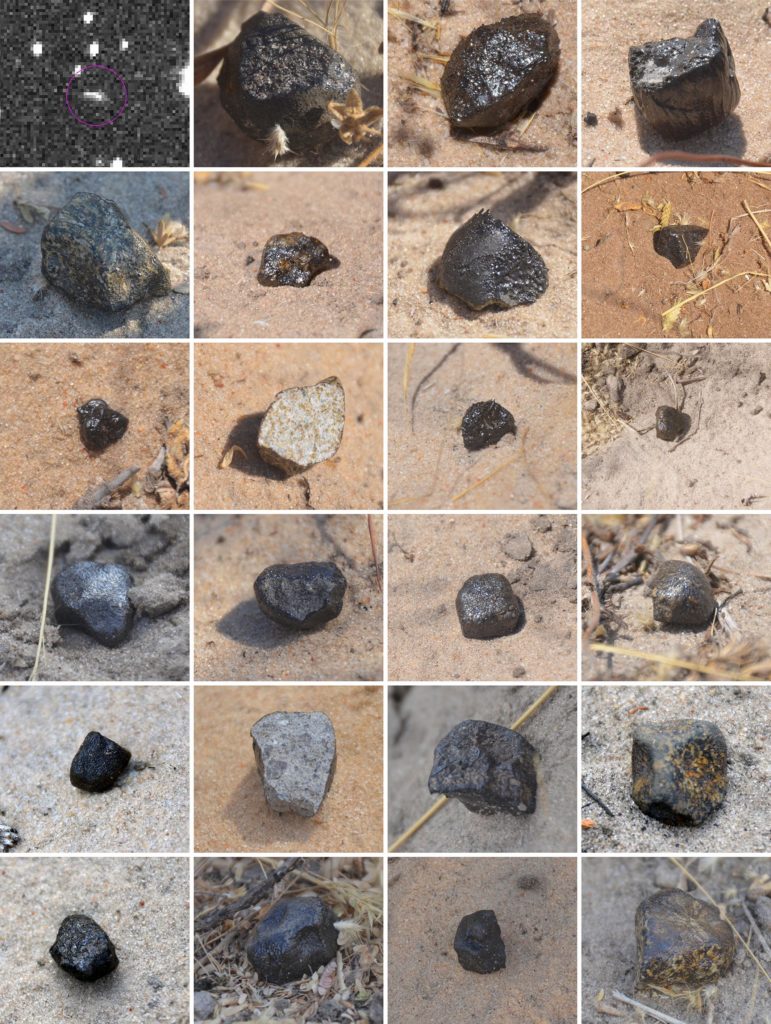
The 23 Motopi Pan meteorite masses found in 2018 (Pictures: 2018 LA in space; meteorites in find order: left to right, then top to bottom, MP#1-MP#23). Image: Jenniskens et al. / ANU
2018 LA ———- MP-01 (17.92 g), MP-02 (4.28 g), MP-03 (10.08 g)
MP-04 (13.16 g), MP-05 (2.59 g), MP-06 (8.55 g), MP-07 (0.51 g)
MP-08 (3.95 g), MP-09 (4.96 g), MP-010 (0.89 g), MP-11 (4.51 g)
MP-12 (3.60 g), MP-13 (3.76 g), MP-014 (4.35 g), MP-15 (2.71 g)
MP-16 (1.35 g), MP-17 (4.93 g), MP-018 (0.90 g), MP-19 (6.19 g)
MP-20 (1.85 g), MP-21 (7.60 g), MP-022 (4.73 g), MP-23 (8.85 g)
The first find (17.92 g, 23 June 2018)
Motopi Pan meteorite #1 (17.92 grams) in situ. Photo: Alexander Proyer
Motopi Pan meteorite #1 (17.92 grams) in situ (close-up). Photo: Peter Jenniskens/Botswana International University of Science and Technology (BIUST)
Motopi Pan meteorite #1 (17.92 grams) in situ. Photo: Fulvio Franchi
Motopi Pan meteorite #1 (17.92 grams) presented at the press conference at the University of Botswana. Photo (left): University of Botswana. Photo: (right): Onalenna Dube
Members of the first search team. Mohutsiwa Gabadirwe (left background), Lesedi Seitshiro (center left), Alexander Proyer (center background), Peter Jenniskens (center right), Oliver Moses (right) and members of the search team at the find location. Photo: Peter Jenniskens
The team pointing at Motopi Pan meteorite #1 (17.92 grams). Photo: Peter Jenniskens
Motopi Pan meteorite #1 (17.92 grams) in situ (close-up). Photo: Peter Jenniskens
Motopi Pan meteorite #1 (17.92 grams). Photo: Matias Takala
Motopi Pan meteorite #1 (17.92 grams). Photo: Matias Takala
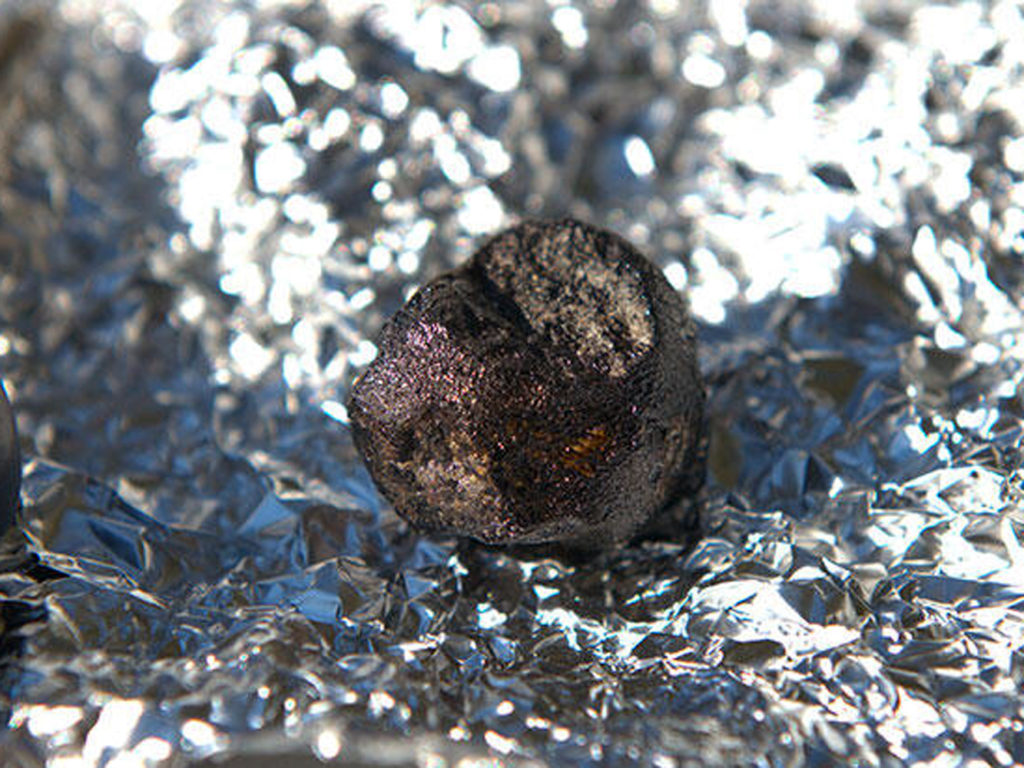
A found meteorite. Photo: Sanni Turunen/ Helsinki University
The second find (4.28 g, 9 October 2018)

Motopi Pan meteorite #2 (4.28 g) in situ, found by Mohutsiwa Gabadirwe on 9 October 2018. Photo: Peter Jenniskens

Motopi Pan meteorite #2 (4.28 g) in situ, found by Mohutsiwa Gabadirwe on 9 October 2018. Photo: Peter Jenniskens
The sixth find (8.55 g, 11 October 2018)

Motopi Pan find #6 (8.55 g) in situ. Photo: Peter Jenniskens
The twenty-fourth find (main mass) (92.3175 g, 7 November 2020)
The 92-gram main mass in situ at location 21.22751° S, 23.15885° E on 7 November 2020. Photo: Fulvio Franchi / BIUST

The 92-gram main mass in situ at location 21.22751° S, 23.15885° E on 7 November 2020. Photo: Fulvio Franchi / BIUST (published: 8 November 2020)
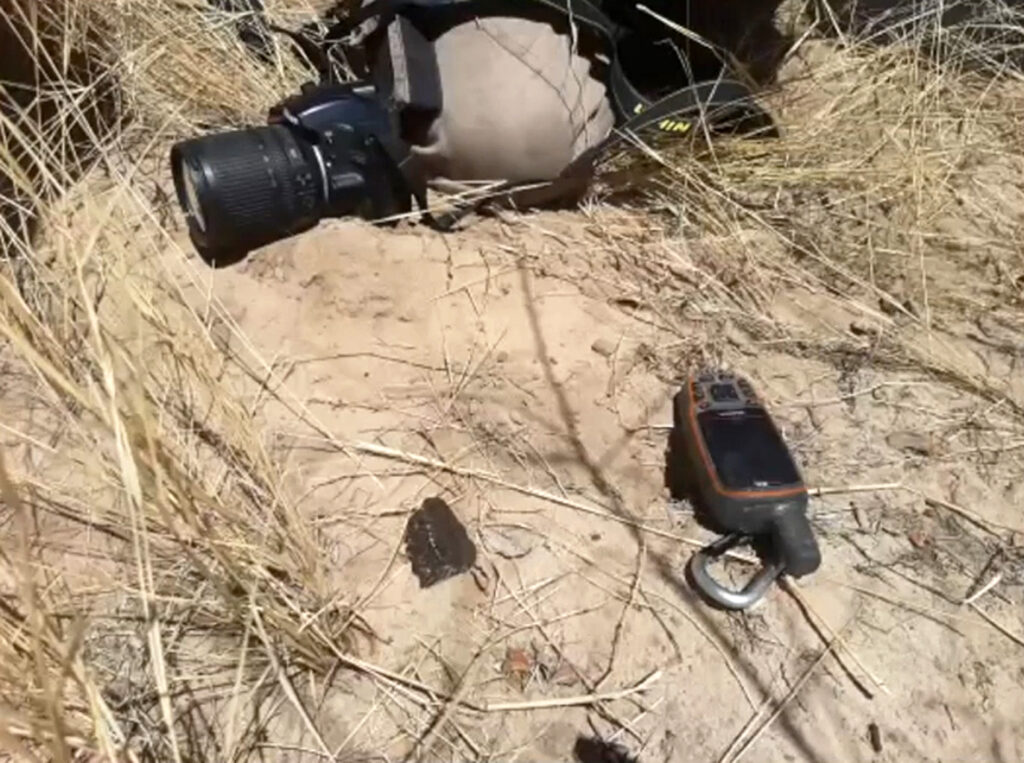
The 92-gram main mass in situ at location 21.22751° S, 23.15885° E on 7 November 2020. Photo: Fulvio Franchi / BIUST

Fulvio Franchi, Thato Makgane and the search team after finding the 92-gram mass on 7 September 2020. Photo: Fulvio Franchi / BIUST
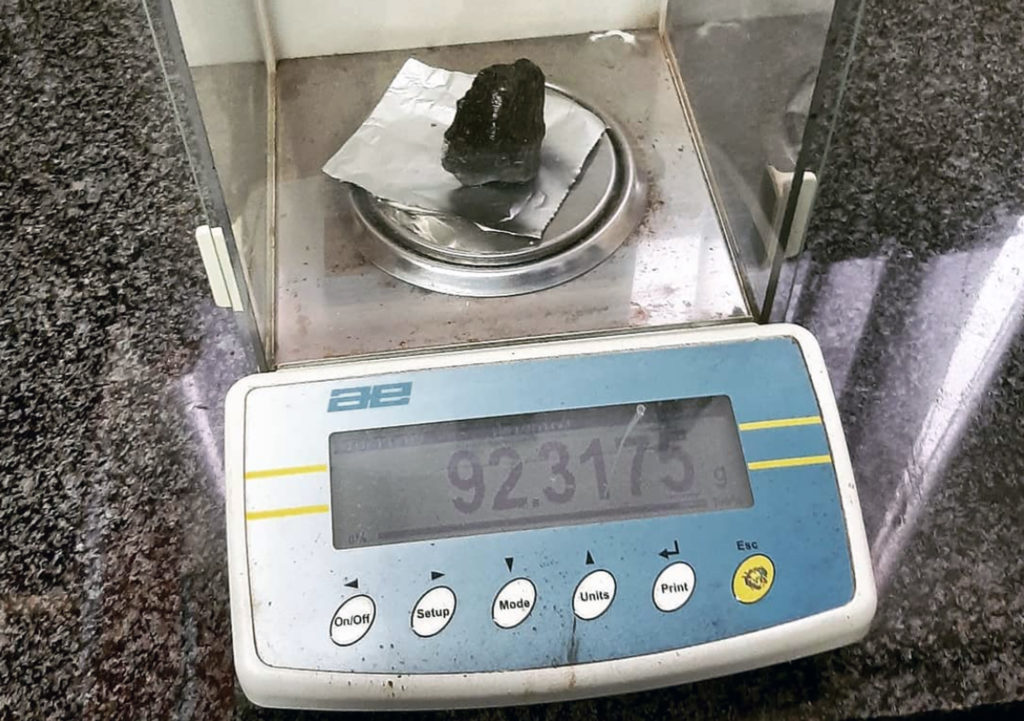
Weighing the 92-gram main mass, found by Thato Makgane on 7 November 2020. Photo: Fulvio Franchi / BIUST (published: 11 November 2020)

Close-up of photo above. Photo: Fulvio Franchi / BIUST (published: 11 November 2020)
Preatmospheric orbit
Press releases
LINK (University of Helsinki, 6 July 2018)
LINK (SETI, 6 July 2018)
LINK (University of Botswana)
LINK SETI Institute (22 April 2021)
Press conference (July, 2018)
Tiyapo Ngwisanyi of Botswana Geoscience Institute (BGI), Alexander Proyer (BIUST), Mohutsiwa Gabadirwe (BGI) and Oliver Moses (ORI) are giving information about the meteorite, the meteorite search and future plans in a press conference at the University of Botswana. Video: Gabzfm News (published 6 July 2018)
Botswana Law
VOLUME: XIII, MONUMENTS AND RELICS, CHAPTER: 59:03
Online media coverage
LINK (6 July 2018)
LINK (6 July 2018)
LINK (6 July 2018)
The bolide of asteroid 2018 LA
Recording by Barend Swanepoel’s (the father) neighbor’s (Vicus van Zyl) CCTV camera at his farm at location 26.752972 S, 26.18866 E between Hartebeesfontein and Ottosdal, South Africa. Video by Vicus van Zyl, uploaded by Barend Swanepoel (the son).
Video from Randfontein, Gauteng (-26.1541°, 27.6800°)
Video of the bolide by B. Lombard from Gaborone. Camera location: -24.6459°, 25.8157°
CCTV recording of the bolide by O. Delport from camera location -26.7229°, 22.3395°
CCTV camera of ‘Kuruman Radiators’ in Kuruman, South Africa at location -27.471877, 23.432932 (time is wrong). Video: Christian Matthys Grobler
The bolide from camera location -24.6225°, 25.9158° in Gaborone Botswana. Photo: Dhiraj Sharma
The Apollo NEO 2018 LA / ZLAF9B2 was discovered at 8:14 UTC by the Mount Lemmon Survey (MLS)/Catalina Sky Survey, 8.5 hours prior to impact.
Orbit data of 2018 LA (JPL Small-Body Database)

Catalina Sky Survey observer Richard Kowalski’s discovery images of 2018 LA (NEO ZLAF9B2) in a 4-frame animation. Images : Catalina Sky Survey.
AMS reports for event 1924-2018
Bill Gray’s Pseudo-MPEC for ZLAF9B2.
A simulation of the ZLAF9B2 trajectory on orbitsimulator
Simulation of the approach trajectory of ZLAF9B2
Dhiraj S provided this AMS observation report about his sighting from location (24°37’21”S, 25°54’57”E) in Gaborone in the South-East District of Botswana at 16:44 UTC.
Peter Brown reports a “strong infrasound detection of a bolide at station I47 in South Africa today at 1730 UT. Origin time between 1645-17 UT over Botswana. Yield 0.3-0.5 kT, corresponding to 2m diameter asteroid.”
Video presentations on the Motopani meteorite fall and the strewn field calculations
Video presentation “From Vesta to the Kalahari, on the trail of the Motopi Pan meteorite” by Tim Cooper on the Twelfth ASSA Symposium on 15 October 2022. Video: Astronomical Society Southern Africa
Presentation “L’incredibile storia del meteorite ‘Motopi Pan’: da pericolo spaziale a tesoro nazionale” by Prof. Fulvio Franchi on 15 February 2023. Video: Società Geologica Italiana





